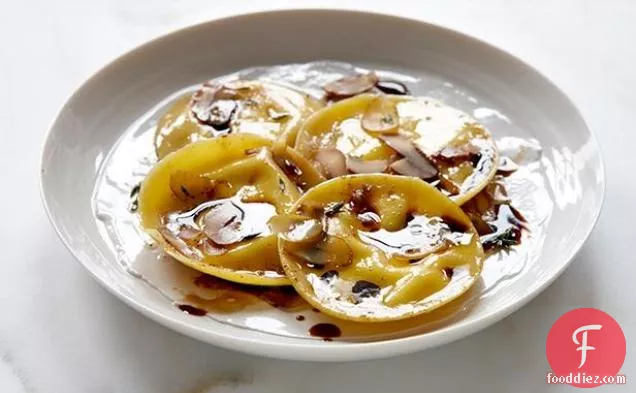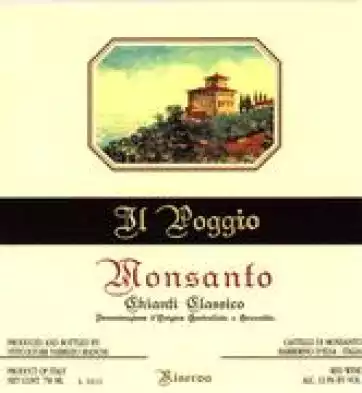Chestnut Ravioli with Browned Butter and Thyme

You can never have too many main course recipes, so give Chestnut Ravioli with Browned Butter and Thyme a try. This recipe makes 4 servings with 790 calories, 33g of protein, and 44g of fat each. This recipe covers 24% of your daily requirements of vitamins and minerals. Head to the store and pick up wonton wrappers, chestnuts, butter, and a few other things to make it today. To use up the chestnuts you could follow this main course with the Dark Chocolate-Caramel Cake with Gold-Dusted Chestnuts as a dessert. From preparation to the plate, this recipe takes about 40 minutes. This recipe is typical of Mediterranean cuisine.
Instructions
1
Place the chestnuts and 1/2 cup water in a small heatproof bowl. Microwave until the water is hot and the chestnuts have softened, about 3 minutes.
Ingredients you will need![Chestnuts]() Chestnuts
Chestnuts![Water]() Water
Water
Equipment you will use![Microwave]() Microwave
Microwave![Bowl]() Bowl
Bowl
2
Drain the chestnuts (reserving the liquid) and place in the bowl of a food processor. Blend with 1 tablespoon of the reserved liquid until finely ground.
Ingredients you will need![Chestnuts]() Chestnuts
Chestnuts
Equipment you will use![Food Processor]() Food Processor
Food Processor![Bowl]() Bowl
Bowl
3
Add the 1 1/2 cups of the Parmesan, the ricotta and a large pinch of salt and pepper. Blend until completely smooth. Taste for seasoning and adjust with additional salt and pepper if needed.
Ingredients you will need![Salt And Pepper]() Salt And Pepper
Salt And Pepper![Seasoning]() Seasoning
Seasoning![Parmesan]() Parmesan
Parmesan![Ricotta Cheese]() Ricotta Cheese
Ricotta Cheese
6
Bring a large stockpot of salted water to a boil (it should taste like sea water).
Ingredients you will need![Water]() Water
Water
Equipment you will use![Pot]() Pot
Pot
8
Whisk the remaining egg in a small bowl with 1/2 teaspoon water.
Ingredients you will need![Water]() Water
Water![Egg]() Egg
Egg
Equipment you will use![Whisk]() Whisk
Whisk![Bowl]() Bowl
Bowl
11
Place a leveled tablespoon of the chestnut filling in the center of each wonton skin.
Ingredients you will need![Chestnuts]() Chestnuts
Chestnuts
12
Place 5 more wonton skins directly on top. Use your fingers to gently press the skins together. Use a 2 1/2-inch round cookie or biscuit cutter lightly dipped in flour to cut around the filling.
Ingredients you will need![Biscuits]() Biscuits
Biscuits![Cookies]() Cookies
Cookies![All Purpose Flour]() All Purpose Flour
All Purpose Flour
13
Transfer the filled raviolis to a baking sheet lined with parchment paper and cover with a slightly damp paper towel. Make 15 additional raviolis with the remaining wonton skins and filling.
Ingredients you will need![Ravioli]() Ravioli
Ravioli
Equipment you will use![Baking Paper]() Baking Paper
Baking Paper![Baking Sheet]() Baking Sheet
Baking Sheet![Paper Towels]() Paper Towels
Paper Towels
14
Once all of the raviolis are made, make the brown butter sauce.
Ingredients you will need![Ravioli]() Ravioli
Ravioli![Butter]() Butter
Butter![Sauce]() Sauce
Sauce
15
Place the butter, garlic and thyme in a large, straight-sided saute pan.
Ingredients you will need![Butter]() Butter
Butter![Garlic]() Garlic
Garlic![Thyme]() Thyme
Thyme
Equipment you will use![Frying Pan]() Frying Pan
Frying Pan
16
Heat over medium heat until the butter starts to bubble and foam, about 5 minutes, stirring occasionally. Continue cooking until the foam subsides and brown specks start to appear, 1 to 2 minutes, stirring constantly. Turn off the heat and cover with a lid to keep warm while you cook the raviolis.
Ingredients you will need![Ravioli]() Ravioli
Ravioli![Butter]() Butter
Butter
17
In batches, add the raviolis one at a time to the boiling water, stirring after every addition. Cook until the raviolis float to the top, about 2 minutes. Use a slotted spoon to remove from the water and add to the browned butter; it is okay if some pasta water gets in the sauce. Toss the raviolis in the sauce. Continue with the remaining raviolis.
Ingredients you will need![Water]() Water
Water![Ravioli]() Ravioli
Ravioli![Butter]() Butter
Butter![Sauce]() Sauce
Sauce
Equipment you will use![Slotted Spoon]() Slotted Spoon
Slotted Spoon
Equipment
Ingredients
4servings![Balsamic vinegar, for drizzling, optional]() Balsamic vinegar, for drizzling, optional142grams
Balsamic vinegar, for drizzling, optional142grams![cup canned chestnuts (about , plus 3 for garnish]() cup canned chestnuts (about , plus 3 for garnish2larges
cup canned chestnuts (about , plus 3 for garnish2larges![eggs]() eggs4cloves
eggs4cloves![garlic, lightly smashed]() garlic, lightly smashed4servings
garlic, lightly smashed4servings![Kosher salt and freshly ground black pepper]() Kosher salt and freshly ground black pepper473milliliters
Kosher salt and freshly ground black pepper473milliliters![ounces Parmesan, finely grated (about]() ounces Parmesan, finely grated (about118milliliters
ounces Parmesan, finely grated (about118milliliters![ricotta]() ricotta2larges
ricotta2larges![fresh thyme sprigs]() fresh thyme sprigs1stick
fresh thyme sprigs1stick![unsalted butter]() unsalted butter40
unsalted butter40![wonton wrappers]() wonton wrappers
wonton wrappers
 Balsamic vinegar, for drizzling, optional142grams
Balsamic vinegar, for drizzling, optional142grams cup canned chestnuts (about , plus 3 for garnish2larges
cup canned chestnuts (about , plus 3 for garnish2larges eggs4cloves
eggs4cloves garlic, lightly smashed4servings
garlic, lightly smashed4servings Kosher salt and freshly ground black pepper473milliliters
Kosher salt and freshly ground black pepper473milliliters ounces Parmesan, finely grated (about118milliliters
ounces Parmesan, finely grated (about118milliliters ricotta2larges
ricotta2larges fresh thyme sprigs1stick
fresh thyme sprigs1stick unsalted butter40
unsalted butter40 wonton wrappers
wonton wrappersRecommended wine: Chianti, Trebbiano, Verdicchio
Chianti, Trebbiano, and Verdicchio are my top picks for Italian. Italians know food and they know wine. Trebbiano and Verdicchio are Italian white wines that pair well with fish and white meat, while Chianti is a great Italian red for heavier, bolder dishes. The Castello di Monsanto Il Poggio Chianti Classico Riserva with a 4.8 out of 5 star rating seems like a good match. It costs about 40 dollars per bottle.

Castello di Monsanto Il Poggio Chianti Classico Riserva
Born in the vineyard “Il Poggio” (5.5 Ha, 310 metres a.s.l.) from which in 1962, it took its name: it is the first Chianti Classico Cru. Made of 90% Sangiovese and from 7% Canaiolo and 3% Colorino, it ages for 20 months in French oak barrels. Today it represents the most prestigious product of the company, appreciated all over the world. It is produced only in the best vintages. The company has chosen to keep a considerable quantity of bottles of this wine in the cellar being the permanent archives, able to tell the history of Castello di MonsantoDifficultyHard
Ready In40 m.
Servings4
Health Score13
Related recipes
Turkey with Country Ham Stuffing
Party Italian Wedding Soup
Turkey Alfredo Tetrazzini
Stuffed Shells with Meat Sauce
Magazine

Your Inner Chef with Taylor Swift's Top 3 Recipes from Her Beloved NYC Hangout

20 Mouthwatering Recipes You Need to Try Today!

Master the Art of Making Perfect Pancakes with This Foolproof Recipe

The Science Behind Red Wine: Its Surprising Health Benefits and Potential Risks

12 Wine Cocktails for a Sophisticated Twist

Sip, Swirl, and Celebrate: Toasting to National Wine Day on May 25th

National Drink Wine Day on February 18

Celebrating Souffle Day with Delectable Delights

Indulge in the Delightful Flavor of Oyster Soup on Its Special Day!

Celebrating World Nutella Day

How to Cook Sushi Rice

How to Make Ice Cream in A bag

How to Make Sushi

How to Make Vegan Pasta

19 Avocado Recipes So You Never Waste One Again

21 Cabbage Recipes to Eat Every Night of the Week

14 Fantastic Cucumber Recipes for Your late Summer

16 Healthy Kale Recipes

23 Spinach Recipes You'll Want to Eat Every Day

8 Watermelon Recipes You'll Crave

Your Inner Chef with Taylor Swift's Top 3 Recipes from Her Beloved NYC Hangout

20 Mouthwatering Recipes You Need to Try Today!

The Science Behind Red Wine: Its Surprising Health Benefits and Potential Risks

Sip, Swirl, and Celebrate: Toasting to National Wine Day on May 25th

National Drink Wine Day on February 18

Indulge in the Delightful Flavor of Oyster Soup on Its Special Day!

Celebrating World Nutella Day

These Super Recipes for Your Football Party!

The Secrets Behind 3 Classic Comfort Food Recipes












